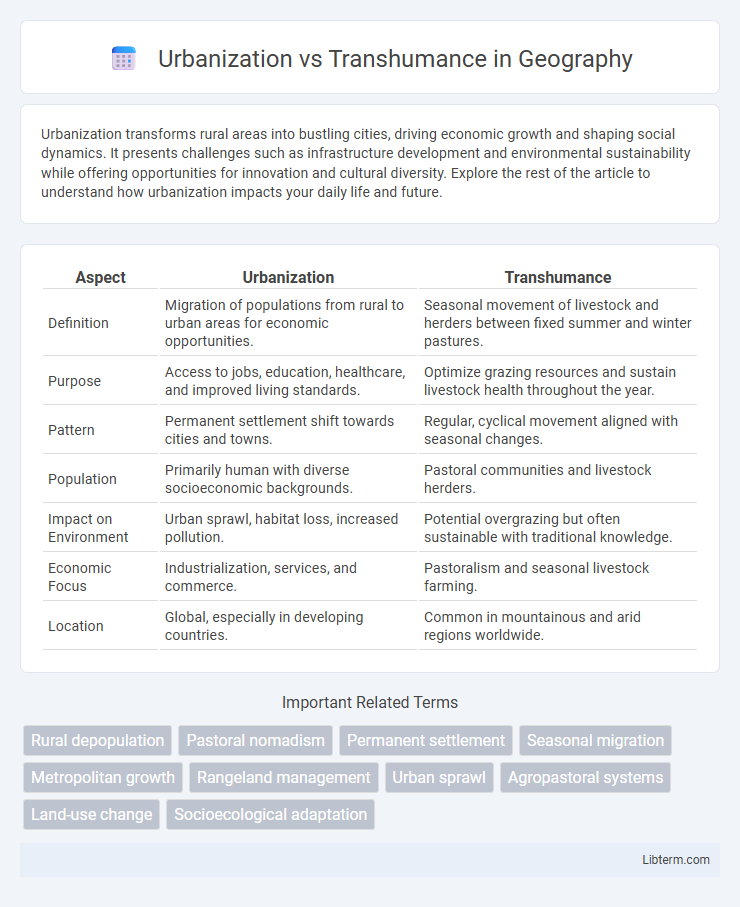Urbanization transforms rural areas into bustling cities, driving economic growth and shaping social dynamics. It presents challenges such as infrastructure development and environmental sustainability while offering opportunities for innovation and cultural diversity. Explore the rest of the article to understand how urbanization impacts your daily life and future.
Table of Comparison
| Aspect | Urbanization | Transhumance |
|---|---|---|
| Definition | Migration of populations from rural to urban areas for economic opportunities. | Seasonal movement of livestock and herders between fixed summer and winter pastures. |
| Purpose | Access to jobs, education, healthcare, and improved living standards. | Optimize grazing resources and sustain livestock health throughout the year. |
| Pattern | Permanent settlement shift towards cities and towns. | Regular, cyclical movement aligned with seasonal changes. |
| Population | Primarily human with diverse socioeconomic backgrounds. | Pastoral communities and livestock herders. |
| Impact on Environment | Urban sprawl, habitat loss, increased pollution. | Potential overgrazing but often sustainable with traditional knowledge. |
| Economic Focus | Industrialization, services, and commerce. | Pastoralism and seasonal livestock farming. |
| Location | Global, especially in developing countries. | Common in mountainous and arid regions worldwide. |
Understanding Urbanization: Definition and Trends
Urbanization refers to the increasing population concentration in urban areas, driven by migration from rural regions and natural population growth. Key trends include rapid expansion of megacities, infrastructural development, and shifts in economic activities from agriculture to industry and services. Understanding urbanization involves analyzing demographic patterns, land use changes, and socio-economic impacts on both urban and rural communities.
What is Transhumance? Traditional Livelihoods Explained
Transhumance is a traditional form of pastoralism involving the seasonal movement of livestock between fixed summer and winter pastures, primarily practiced in mountainous and arid regions worldwide. This livelihood strategy supports sustainable land use by optimizing grazing resources and maintaining ecological balance through rotational grazing patterns. Urbanization increasingly threatens transhumance by reducing available grazing lands and disrupting traditional migration routes, leading to cultural and economic challenges for pastoral communities.
Historical Evolution: From Rural Roots to Urban Expansion
Transhumance, practiced for millennia, shaped rural economies through seasonal livestock migration between fixed summer and winter pastures, sustaining agricultural societies. Urbanization accelerated notably during the Industrial Revolution, driving mass population shifts from rural transhumant communities to emerging urban centers in search of industrial employment. This historical evolution reflects a transformative shift from traditional, mobility-based rural livelihoods towards permanent urban settlements characterized by industrial growth and socio-economic diversification.
Economic Impacts: Urbanization Compared to Pastoralist Mobility
Urbanization drives economic growth by concentrating labor, infrastructure, and markets, fostering diverse employment opportunities and industrial development. In contrast, transhumance supports pastoralist economies through seasonal livestock grazing, sustaining livelihoods but generating limited market integration and GDP contribution. The shift from transhumance to urbanization often results in increased productivity, higher income levels, and broader access to services, although it can lead to challenges like urban unemployment and loss of traditional pastoral lands.
Social Structures: City Life vs. Nomadic Communities
Urbanization fosters complex social structures with diverse institutions, formal governance, and stratified communities centered around economic and cultural hubs. Transhumance sustains fluid social networks rooted in kinship, cooperative resource management, and adaptive leadership tailored to seasonal migration. City life emphasizes permanent residency and specialized roles, whereas nomadic communities prioritize mobility and flexible social organization.
Environmental Consequences: Urban Footprints vs. Sustainable Grazing
Urbanization significantly increases environmental degradation through expanded urban footprints that consume natural habitats, raise pollution levels, and strain water resources. In contrast, transhumance promotes sustainable grazing by rotating livestock across seasonal pastures, maintaining vegetation cover and soil health, thereby reducing land degradation and preserving biodiversity. While urban growth intensifies carbon emissions and habitat fragmentation, transhumance supports ecosystem balance and mitigates desertification risks in pastoral regions.
Cultural Changes: Loss and Preservation in Urban and Pastoral Societies
Urbanization drives significant cultural shifts, often leading to the loss of traditional practices and indigenous knowledge as communities adapt to modern city life. Transhumance, a pastoral lifestyle involving seasonal livestock migration, preserves cultural identities through the continuation of ancestral customs and landscape stewardship. Efforts to document and integrate transhumant heritage into urban settings play a crucial role in balancing cultural preservation amid rapid societal transformation.
Policy Challenges: Managing Urban Growth and Transhumance Practices
Urbanization drives rapid expansion of cities, creating policy challenges such as land use regulation, infrastructure development, and resource management, especially in regions experiencing high rural-to-urban migration. Transhumance practices require policies that support seasonal livestock movement while preventing land conflicts and ensuring sustainable grazing. Effective management demands integrated strategies to balance urban growth pressures with the preservation of traditional pastoral livelihoods and environmental sustainability.
Modern Innovations: Integrating Pastoralism in Urban Planning
Modern innovations in urban planning increasingly integrate pastoralism by incorporating green corridors, vertical farming, and community grazing spaces within city landscapes to support transhumance lifestyles. Smart technologies like GIS mapping and real-time tracking optimize the movement and management of livestock in urban environments, enhancing sustainability and reducing conflicts between pastoralists and urban residents. These advancements foster a harmonious coexistence of urbanization and traditional transhumance practices, promoting biodiversity and preserving cultural heritage.
Future Outlook: Balancing Urban Development and Pastoral Traditions
The future outlook of urbanization versus transhumance highlights the challenge of balancing rapid urban development with the preservation of pastoral traditions fundamental to many cultures and ecosystems. Sustainable urban planning must integrate green spaces and support for nomadic lifestyles to prevent the erosion of transhumance routes and biodiversity. Emerging technologies and policy frameworks are poised to facilitate coexistence, promoting resilient communities that respect both modern infrastructure growth and the continuity of age-old herding practices.
Urbanization Infographic

 libterm.com
libterm.com